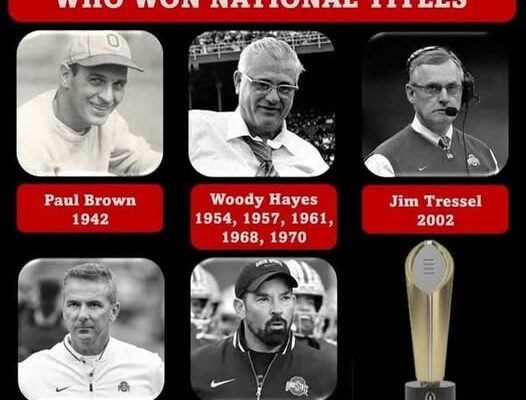“The Coaching Legacy of Ohio State Football: Legends of the Gridiron.”
Ohio State football stands as a beacon of tradition, excellence, and unwavering commitment to the sport of college football. Over the decades, the program has built an extraordinary legacy, not only through its on-field successes but also through the legendary coaches who have shaped the culture and identity of the team. These coaches have become icons in their own right, guiding generations of players and leaving an indelible mark on the sport. The story of Ohio State football’s coaching legacy is a rich tapestry woven with dedication, innovation, leadership, and a relentless pursuit of greatness.
The origins of Ohio State football coaching excellence trace back to the early 20th century, when the foundation of the program was laid by pioneering coaches who brought a strategic vision to the game. One of the earliest figures to influence Ohio State’s rise was John Wilce, who coached from 1913 to 1928. Wilce’s tenure is often credited with professionalizing the team and setting standards that would resonate through the program’s future. He understood the importance of discipline and physical fitness long before these became common in college football. Under his guidance, Ohio State secured its first conference championships, establishing the team as a serious contender in the Big Ten. His impact was not only measured in wins but also in his holistic approach to developing players both on and off the field.
Following Wilce, Ohio State continued to evolve, but it was Paul Brown who would usher in a transformative era that profoundly influenced not just the Buckeyes but football in general. Coaching from 1941 to 1943, and again after World War II from 1946 to 1949, Brown brought an innovative mindset and rigorous attention to detail that became his hallmark. Known for his meticulous preparation and use of game film for analysis, Brown was a pioneer in professionalizing the coaching approach. His coaching style emphasized precision, discipline, and strategy, making the Buckeyes a well-oiled machine on the field. Brown’s success was immediate and impressive; he led Ohio State to its first national championship in 1942. His legacy transcended college football as he later became a founding figure in the National Football League, but his tenure at Ohio State remains a foundational pillar in the program’s coaching heritage.
The post-war years saw Ohio State continuing to build on this foundation, but the true legend of Ohio State coaching was born with Woody Hayes. Hayes’s tenure, from 1951 to 1978, is arguably the most iconic in college football history. Known as “The Hat” for his trademark fedora, Hayes embodied the spirit of Ohio State football with his fiery passion, intense focus, and relentless drive for victory. His coaching style was a blend of physicality, discipline, and old-school toughness. Hayes believed in a powerful running game and a defense that could dominate opponents, a philosophy that became synonymous with Buckeye football.
Under Hayes, Ohio State experienced unprecedented success, capturing five national championships and 13 Big Ten titles. His teams were known for their toughness and ability to perform under pressure. Hayes’s coaching legacy is not just about wins but also about the culture he instilled — one that prized hard work, loyalty, and an unyielding competitive spirit. He was famous for his emotional intensity on the sidelines, sometimes erupting in passionate outbursts, but always deeply committed to his players’ development and well-being. Hayes’s impact on the program is so profound that many regard him as the father of modern Ohio State football, setting a standard of excellence that still echoes today.
The era following Hayes saw Ohio State navigating the challenges of maintaining its storied tradition while adapting to the evolving landscape of college football. Coaches like Earle Bruce, who took over in 1979, carried the torch with a focus on consistency and competitive spirit. Bruce, a former assistant under Hayes, emphasized a balanced approach to the game, blending strong defense with an effective offense. Although he never captured a national championship, Bruce’s tenure was marked by multiple Big Ten titles and bowl appearances, helping to sustain Ohio State’s reputation as a perennial powerhouse.
In the 1990s, Ohio State’s coaching legacy was further enriched by John Cooper. Cooper’s tenure, from 1988 to 2000, was marked by some of the most memorable teams in Buckeye history. Known for his ability to recruit top talent and develop dynamic offenses, Cooper’s teams often boasted explosive playmakers and competitive defenses. Despite some struggles against key rivals, Cooper led Ohio State to several Big Ten championships and major bowl games. His tenure is remembered for its exciting brand of football and the emergence of numerous players who went on to have successful professional careers. Cooper’s impact on the program was significant, as he helped modernize the team’s approach and recruit nationally recognized talent, further expanding Ohio State’s footprint in college football.
The coaching lineage of Ohio State reached new heights with the arrival of Jim Tressel in 2001. Tressel’s era brought a renewed sense of discipline and focus, combined with a winning mentality that culminated in a national championship in 2002. Known for his calm demeanor and strategic acumen, Tressel emphasized a “team-first” philosophy, which resonated with both players and fans. His teams were characterized by their strong defense, efficient offense, and ability to execute in critical moments. Tressel’s leadership helped Ohio State navigate the complexities of the modern college football landscape, including increased media scrutiny and the challenges of maintaining academic standards. His tenure reinforced Ohio State’s image as a football powerhouse committed to excellence both on and off the field.
Following Tressel, Urban Meyer’s arrival in 2012 marked another era of Ohio State coaching greatness. Meyer, already renowned for his success at other programs, brought a dynamic and innovative approach to the Buckeyes. His offensive schemes were aggressive and versatile, adapting to the strengths of his players and often overwhelming opponents. Meyer’s Ohio State teams were marked by speed, creativity, and resilience, culminating in a national championship victory in 2014. His ability to develop quarterbacks and skill position players into elite talents was a hallmark of his coaching style. Meyer’s tenure was also notable for its emphasis on culture-building, team unity, and fostering leadership among players. Despite some controversies, his impact on the program’s modern identity and success is undeniable.
Throughout Ohio State’s coaching history, one constant has been the focus on building not just great teams but also great men. The coaches who have led the Buckeyes have consistently emphasized values such as integrity, accountability, and perseverance. Many of these coaches have maintained strong connections with their players long after their college careers ended, serving as mentors and role models. This commitment to personal development is a key element of Ohio State’s coaching legacy, reinforcing the idea that the program is about more than just football—it’s about shaping lives.
Ohio State’s coaching legacy also reflects the broader evolution of college football. From the early days of rudimentary strategies and regional play to the modern era of national recruiting, advanced analytics, and multimedia exposure, the Buckeyes have been at the forefront of innovation. Coaches like Paul Brown introduced film study and game planning techniques that have become standard practice, while later coaches adapted to the complexities of recruiting, compliance, and player management in a rapidly changing sports landscape. This ability to evolve while maintaining core values has helped Ohio State remain competitive across eras.
Moreover, Ohio State coaches have often been leaders beyond the football field, influencing the sport at large. Many have moved on to professional coaching or administrative roles, spreading the principles and methods developed at Ohio State to the broader football world. Their influence extends into coaching clinics, broadcasting, and even college athletics governance. This ripple effect underscores the program’s importance as a breeding ground for coaching talent and football innovation.
The relationship between Ohio State football coaches and their fans is another integral part of the legacy. Buckeye fans are known for their passion, loyalty, and high expectations, which create a unique environment of support and pressure. Coaches who succeed at Ohio State must navigate this dynamic skillfully, balancing tradition with innovation while managing the intense spotlight that comes with leading one of the nation’s most storied programs. Those who thrive in this environment become legends, their names etched into Ohio State’s rich history.
The coaching legacy of Ohio State football is a testament to the power of leadership, vision, and commitment. It is a story of individuals who have dedicated their lives to excellence in sport and character, creating a program that stands among the elite in college football history. From the pioneering days of John Wilce to the modern innovations of Urban Meyer, the Buckeyes’ coaching heritage is a continuous thread of greatness, resilience, and pride. It is a legacy that inspires not only players and coaches but also fans and communities, embodying the spirit of Ohio State and the enduring passion for football.
In sum, Ohio State’s coaching legacy is not just about championships or records—it is about the enduring influence of coaches who have shaped a program, a culture, and a tradition of excellence. These legends of the gridiron have left a lasting imprint on the university, its athletes, and the sport itself. Their stories of triumph, challenge, and leadership continue to inspire new generations, ensuring that Ohio State football remains a powerhouse and a symbol of what dedicated coaching can achieve.


